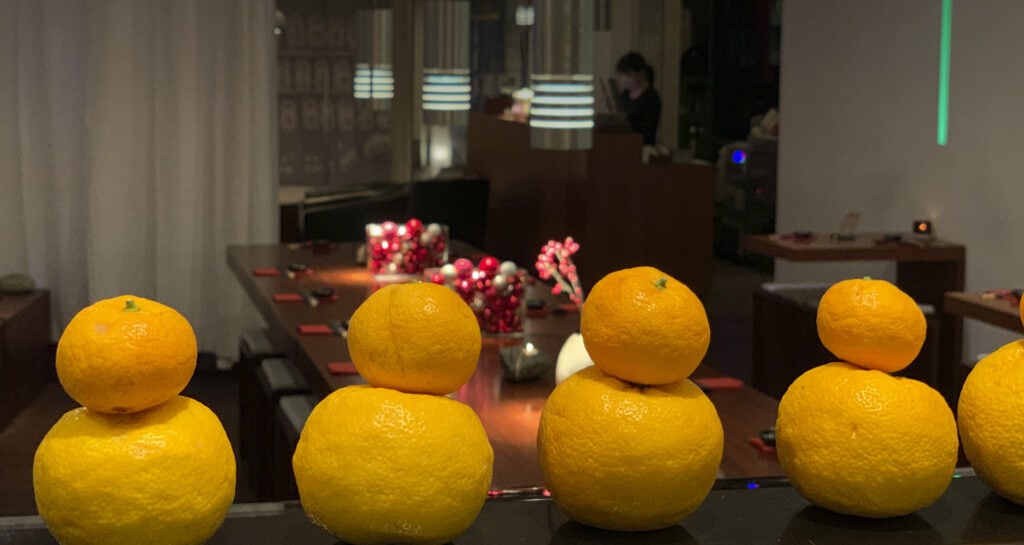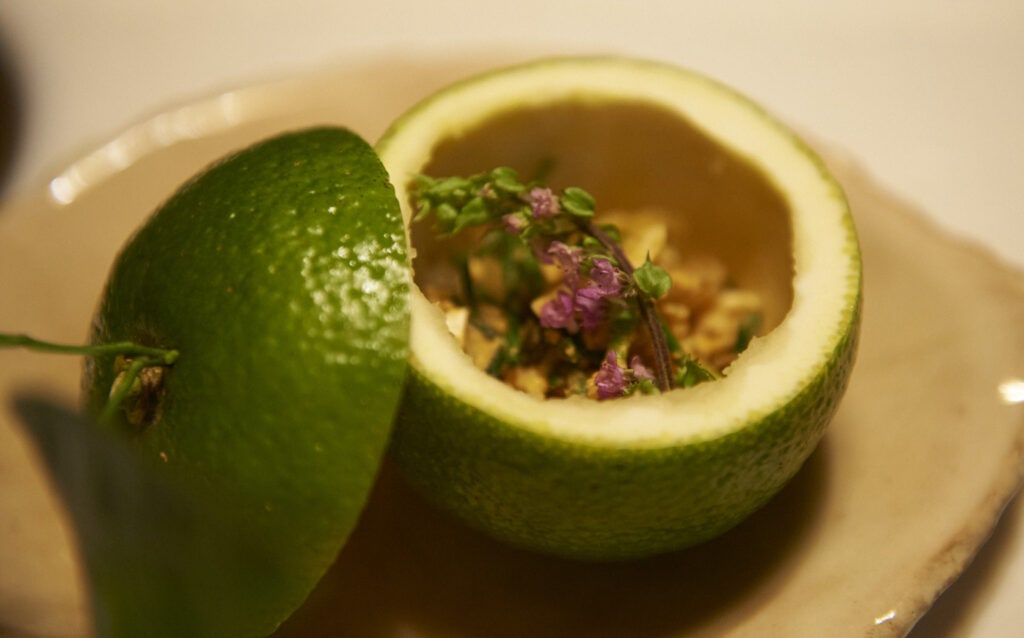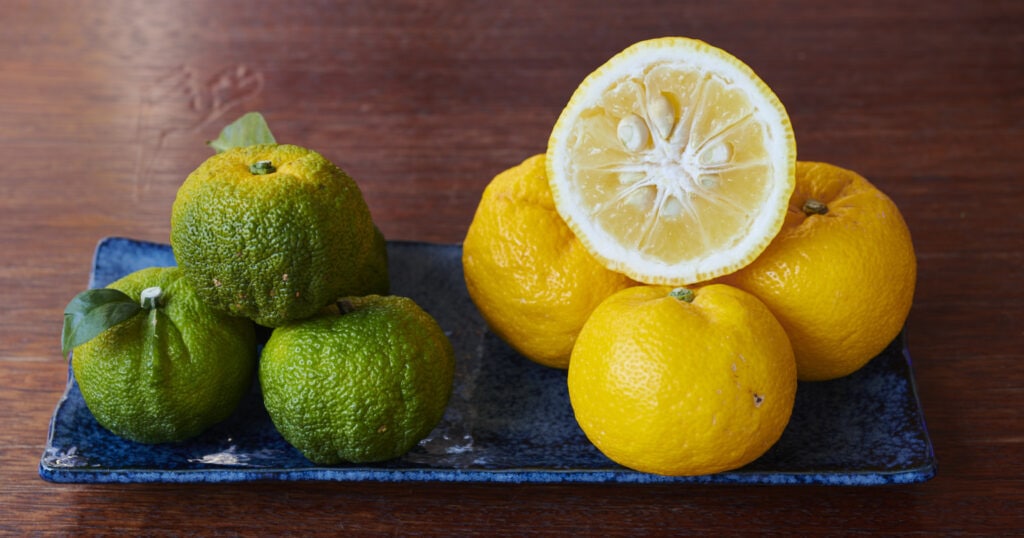Intensely fresh, slightly sour-tart fragrance, yellow to orange coloring and an incredible aroma - this is yuzu, biologically called Citrus x junos. The citrus fruit comes from Japan, is about the size of a tennis ball and enriches cuisine, cocktails and even body care in Japan.
And it can be found every now and then fresh, dried or in small zests in seasonal specials in our Restaurant sansaro in Munich.
Here is some interesting info we have compiled on this legendary Japanese fruit.
What is yuzu?
Yuzu, Citrus x junos, is a citrus fruit of the rue family in the soap tree order. The fruit has been cultivated in China, Korea and Japan for several thousand years. For some years now, yuzu has been extremely popular not only in top European cuisine, but has also been marketed to amateur gardeners as a "hardy lemon". Only a few farms in Europe grow yuzu, Japan is the world's largest producer and consumer of the fruit.
The fruit of the yuzu tree is about the size of a tennis ball and resembles a small grapefruit. In terms of color, the grapefruit is also close: yuzu are harvested as green ao-yuzu from late summer (August), as yellow yuzu in autumn (November/December). The fruits, heavily interspersed with seeds, have a very thick skin and an extremely aromatic exocarp. Exocarp and juice are used in Japanese cuisine as well as by the cosmetics industry.
Where does yuzu come from?
Yuzu is originally from China, but today it also grows in Korea, Japan and even Spain. Where exactly in Asia people first began to use wild yuzu and cultivate yuzu is not entirely clear. The slender trees can be traced back over many thousands of years, with the oldest traces today located in the Yangtze Basin in China.
Citrus x junos is a cross between Citrus ichangensis and Citrus reticulata. Today there are several varieties, sometimes large-leaved, sometimes narrow-leaved, which can have broad or narrow winged leaves. There is even a species with slightly reddish shoots, called Sudachi. Sudachi, which is similar to a lemon and is often used as a seasoning for udon and other dishes, is apparently a genetic descendant of the yuzu. All yuzu plants shed their foliage in winter.
When did yuzu come to Japan?
What does yuzu mean?
Yuzu is the Japanese pronunciation of the Chinese 柚子 yòuzi.
So the Japanese name for the fruit has no meaning for the time being. When the yuzu was introduced to Japan, the name was chosen purely on the basis of the sound. The Chinese characters 柚子 are used in the same way in Japanese. If translated literally, they mean as much as Lemon Child. It is said that the name Yuzu has been used since the Edo period in Japan.

What makes Yuzu special?
Yuzu is so special because of the complex flavors of the fruit. In simpler terms, the taste and smell of yuzu is unique. The citrus fruit is often equated with lemons or compared to tangerines, but neither is quite accurate.
The tart, fresh aroma of lemons is found in yuzu, but to a lesser extent: the Active ingredient lime is present in yuzu to about the same extent as in a lemon. However, the yuzu has only about 2/3 of the acidity of a lemon, which gives the yuzu a refreshing taste with a slight hint of sweetness offers.
Overall, the taste of the fruit goes more in the direction of grapefruit or grapefruit. For a tart to bitter note is also always present. Nevertheless, the aroma is even fresher and fruitier than with a grapefruit.
How does yuzu taste?
The aroma of yuzu is unique. The citrus fruit is often equated with lemons or compared to tangerines, but neither is accurate. The sour-fresh aroma of lemons can be found in the yuzu, but overall the taste of the fruit is more in the direction of grapefruit or grapefruit. For a tart to bitter note is also always present. Nevertheless, the aroma is even fresher and fruitier than a grapefruit.
What is the difference between aroma and flavor?
Human senses are quite limited, especially when it comes to taste. You can easily try this out: Just hold your nose while eating! The human tongue can detect little more than sweet, sour, salty, bitter and umami.
What we describe as the specific "taste" of food is usually the aroma. And this is picked up via the sense of smell and fused into a whole with what the tongue reports in terms of taste.
Yuzu is used for aroma, not flavor - at least in Japan. While the taste is limited to sour and bitter, the aroma is very complex. The oils of the yuzu peel are therefore often used in the perfume industry. In Japan, they are added to bath water. And in the kitchen, of course, the complex aroma is versatile.
What is Yuzukoshō?
The most common seasoning paste made from yuzu in Japan is Yuzukoshō.
This is a paste of pepper (green or red pepper), mixed with salt and the exocarp of yuzu. We distinguish between the green yuzukoshō made from ao-yuzu and green chili pepper, and the orange yuzukoshō made from yuzu and red chili pepper.
The paste has a bitter taste that brings a sharp spice with a slight citrus freshness to the food. It is one of those distinctive condiments that you don't forget once you've been to Japan.
Where to get yuzu?
In Germany, yuzu is rarely available as a fresh fruit. Specialized stores, delicatessens and the like may carry the fruit in season, but the local supermarket certainly does not have yuzu. And even at the Asian specialty food store, it may be nearly impossible to find fresh yuzu. Instead, here (online as in local specialty stores) you can find ponzu, juice, yuzu pearls, and yuzu no hana, yuzu paste and soy sauce with yuzu. There is even pon shabu with yuzu. What is all this now?
What is Yuzu Ponzu?
In Japan, if you ask for the things that should not be missing in the kitchen, they immediately ask for rice, Soy saucesalt and miso. Only then come other seasonings and this certainly includes yuzu ponzu.
Yuzu Ponzu is a soy sauce that has been mixed with yuzu and has a slightly lemony taste. Since the highly structured Japanese everyday life often lacks the time to really prepare everything by hand, there are of course inexpensive ready-made products available in Japan. Yuzu ponzu is one such product. Sometimes vinegar or ajinomoto (a seasoning based on monosodium L-glutamate) are also hidden in the ponzu, each manufacturer has its own mixture - and each housewife has her own preferences.
Ponzu belongs to Tataki and Sashimibut is also served with nabemono and shabu-shabu. Good fits ponzu also with katsuo sashimi (bonito).
What is yuzu juice for?
If, on the other hand, you like to mix your own seasoning for dishes, reach for yuzu juice or direct juice. Packed in dark bottles protected from light, the juice keeps for a long time and can be used for salad dressing, sauces for vegetables and meat and even for cocktails and fruit juice mixtures. Popular in winter is hot yuzu, which is roughly comparable to the German hot lemon.
What are yuzu pearls?
Yuzu is mostly used in the kitchen in the form of juice or powder - why now pearls? Yuzu Ponzu pearls consist of yuzu ponzu in alginate capsules. This is very decorative and makes a great visual impact in fish dishes or salads. We know: The eye eats with you! Whether the pearls with calcium lactate, xanthan, potassium sorbate and many other additives really have to be, everyone decides for themselves. Yuzu pearls have nothing to do with traditional Japanese cuisine. By the way, if you need an eye-catcher for the party, go for yuzu sake pearls. With an alcohol content of around 10 percent, the small pearls are pretty to look at in cocktails and also give desserts a special touch.
What is Yuzu no Hana?
Yuzu no Hana is the name for yuzu peel that has been dried and ground into powder. The slightly greenish, fine powder peps up noodle soups (from ramen to soba, enjoyed cold in summer) and can be used as a convenience product in all kinds of sauces and dips. In the original, of course, freshly grated yu shell should be used.
What is yuzupaste?
In this country, hardly anyone makes ketchup, mustard or mayonnaise themselves. In Japan, the seasoning sauce for meat and fish, vegetables and salads is increasingly rarely mixed fresh at home. Yuzupaste helps if you do make a half-hearted attempt (and still reach for a convenience product again), but ready-mixed sausage sauces filled in handy bottles are also available. Pon Shabu, Nama Ponzu and similar names are given to the yuzu-infused dips and sauces.
What is yuzu tea?
Yuzu is still grown today in the south of Korea, especially in the area around Jeju Island. In Korea, yuzu tea is very popular. For the tea, yuzu is steeped in honey and then brewed with hot water. There are also recipes that preserve yuzu in sugar and then brew it. As a finished product, the tea is also available in Asia store in Germany.
Can you grow yuzu in Germany?
Yes, you can grow yuzu in Germany. Theoretically.
Yuzu plants, or more accurately Citrus x junos, are sold in this country as "hardy lemon" and are said to thrive beautifully anywhere from the living room to the outdoors. The upright growing tree bears tight branches and winged leaves. Like many other citrus plants, the plants bear small thorns. The yuzu can withstand temperatures as low as minus 10 degrees Celsius outdoors - so the mild areas around Lake Constance to the river valleys seem to be suitable for yuzu. Or, to put it another way, the German wine-growing regions have the suitable climate.
However, we strongly advise against simply planting a yuzu tree in the garden. Yuzu are not native here, import and cultivation of non-native plants disrupts the natural balance. The so-called neophytes, which repeatedly "escape" from front gardens and even professional planting companies and spread in nature, cause great damage. And it takes many, many years before you can harvest for the first time....
What climate needs yuzu?
When to harvest yuzu?
Yuzu trees have a long life, and it takes a very long time before they bloom and bear fruit for the first time. One can expect from about 18 years go out: That's how long it takes to go from seed to edible fruit.
In Japan they even know a Proverb to this: It takes three years to grow a peach, three years to grow a chestnut, eight years to grow a persimmon, and 18 years to grow a yuzu. Yuzu plants grow extremely slowly.
Yuzu is harvested in the fall, but the fruit is available throughout the winter and sold into the following spring.
In Japan, a distinction is made between ao-yuzu and yuzu. Ao-yuzu is harvested unripe, the fruits can be brought in as early as August and September. Yuzu, on the other hand, is harvested between October and December (depending on the region). Because the green ao-yuzu have less juice, the outer skin of the fruit (exocarp) is used in cooking. This peel is used to make the yuzu powder.
How to replace yuzu?
Is yuzu healthy?
Where is yuzu grown in Europe?
Why is yuzu so expensive?
This also explains why fresh yuzu is so extremely expensive in Europe: The individual fruit costs between 5 and 20 euros, if it is actually available. Yuzu must be harvested when ripe. Like all citrus fruits, yuzu does not ripen after harvesting. The thick, highly oily skins of the fruit prevent it from drying out and keep it fresh for a long time, at least in a cool environment. But after three weeks, the quality does start to decline. It is incredibly costly to process yuzu in the kitchen here in Germany within three weeks of harvest in Japan!
What do you eat from the yuzu?
A second reason why yuzu is costly, even in processed and preserved form, is the nature of the fruit. The skin is very thick, which is why the fruit itself is rather small. The flesh is very interspersed with seeds. The seeds contain bitter substances that would simply kill the complex aroma of the yuzu. Therefore, the seeds must be removed before processing. From the yuzu itself then not much remains...
Can you eat yuzu?
Yes, but it's no fun. Because the relatively many, relatively large seeds that are in the pulp make it almost impossible to eat like an orange. The special flavor of the yuzu comes from the peel, which is why upscale cuisine likes to grate the peel onto other dishes or extract the juice from the pulp.
Yuzu is an asset!
So we hold: The great aroma of yuzu can be used in many ways in the kitchen as well as cosmetics. It is probably the most versatile and exciting citrus fruit. Accordingly, the current hype around yuzu is great. Worldwide, scientific studies are looking at the fruit, among other things with regard to the calming effect of its scent. But why is yuzu so popular in Japan?
It is, of course, also here the aroma. Yuzu is irresistible: anyone who has had the chance to sniff this fruit or enjoy its rich aroma in a dish will never forget it.
But the yuzu is said to this day in Japan that it is
- stimulates the blood circulation
- Prevents colds
- Relieves feelings of cold
- gives beauty to the skin.
Of course, the scientific evidence for these great effects is still pending - that has yuzu in common with other superfoods!
After all, the Kochi University in cooperation with Umaji Village Agricultural Cooperation prove otherwise in studies: The oil from the seeds of the yuzu can relieve mild neurodermatitis and treat dry skin. The oil also has a soothing effect on xeroderma (so-called moonshine disease).
Who knows what else the researchers will find out in the next few years.
Meanwhile, we stick to the fact that yuzu is simply incredibly aromatic and one of the best things that the japanese food culture has to offer!








